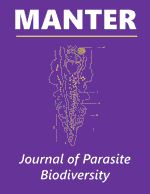Parasitology, Harold W. Manter Laboratory of
ORCID IDs
ORCID: 0000-0003-1415-4097
Date of this Version
12-30-2022
Document Type
Article
Citation
MANTER: Journal of Parasite Biodiversity,) Occasional Papers, Number 30, December 30, 2022
doi: 10.32873/unl.dc.manter30
Abstract
A prevalent concept for colonization and evolution among plant pathogens and their hosts stems from a post-Darwinian paradigm rooted in the formalized assumption of “specialized parasitism.” Seminal studies on rust fungi of socioeconomic importance integrated such an evolutionary perspective driven by the assumption of strict coevolution among pathogens and their plant hosts. Following this fundamentally unfalsifiable assumption, theories regarding host-switching for parasites were dismissed. If colonization occurred, this process would depend upon the origin of specific and novel mutations that allow infections of previously unexploited hosts or host groups, the acquisition of a broader host range. After a specific mutation arose, parasites and hosts would be locked into an eventual evolutionary dead end (e.g., codified under Dietel’s Law). Accordingly, if the parasites are highly specialized (one parasite, one plant), then new associations are rare or otherwise unpredictable. Similar schools of thought became dominant for animal pathogens and were established during the same period (i.e., Müller’s rule, Fuhrmann’s rule, and Fahrenholz’s rule). Other studies that focused on plant pathogens took the one host–one parasite idea for granted and only tentatively included evolutionary insights in subsequent development of plant pathogen scientific frameworks. Later, emerging from neo-Darwinian views, the paradigm of strict cospeciation was conflated with the gene-for-gene rule postulated in 1956 and which has persisted among phytopathologists even to the present day. In a parallel history, conceptual development among plant pathologists and parasitologists has assumed that colonization is rare and cannot be predicted, given the dependence on the origin of the elusive special mutation. In contrast, current impacts and increasing frequency of emerging pathogens and epidemics across the globe, which influence health and food security, suggest that this historical approach fails in describing a complex biosphere in dynamic change. The Stockholm paradigm (SP) provides a powerful alternative to what may be regarded as the standard model of coevolutionary diversification. The SP creates a theoretical workbench from which emergence of new associations can be evaluated and predicted. The SP provides a new perspective in exploring the dynamics among the phytoplasmas, an emergent group of plant pathogens with substantial risk for food security. New insights are examined, pushing for resolution of the internal conflicts generated by assumptions of the standard coevolutionary model, which has dominated the scientific reasoning for more than a century of plant pathology research.


Comments
Copyright © 2022 Valeria Trivellone